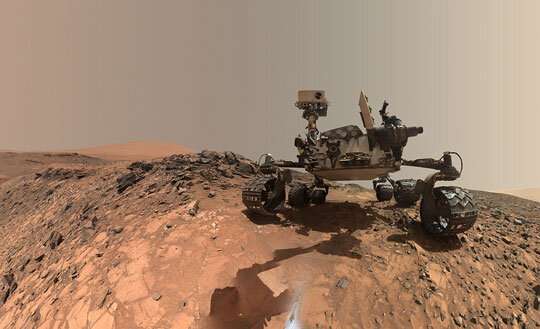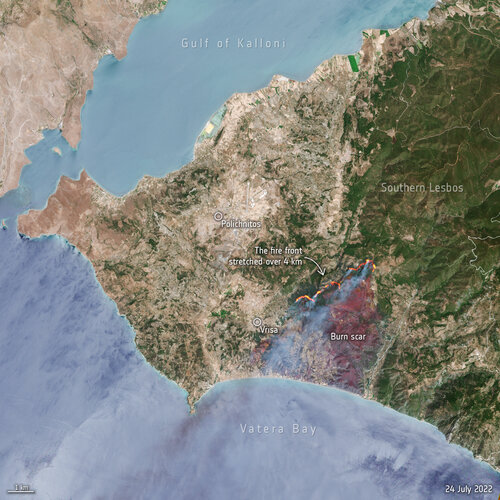Terran Orbital completes Space-to-Ground Optical Link demonstration on Pathfinder Technology Demonstrator 3
Tuesday, 26 July 2022 11:15 Terran Orbital Corporation (NYSE: LLAP), a global leader in satellite solutions, primarily serving the United States and Allied aerospace and defense industries, has announced the first signal acquisition of the Terabyte Infrared Delivery (TBIRD) Lasercom Optical Link on NASA's Pathfinder Technology Demonstrator 3 (PTD-3) satellite.
Acquisition of the Lasercom Optical Link means that the s
Terran Orbital Corporation (NYSE: LLAP), a global leader in satellite solutions, primarily serving the United States and Allied aerospace and defense industries, has announced the first signal acquisition of the Terabyte Infrared Delivery (TBIRD) Lasercom Optical Link on NASA's Pathfinder Technology Demonstrator 3 (PTD-3) satellite.
Acquisition of the Lasercom Optical Link means that the s US-European satellite will make world's first global freshwater survey
Tuesday, 26 July 2022 11:15 Water is life, but for all its importance, humanity has a surprisingly limited view of Earth's freshwater bodies. Researchers have reliable water level measurements for only a few thousand lakes around the world, and little to no data on some of the planet's important river systems. The upcoming Surface Water and Ocean Topography (SWOT) satellite will fill that enormous gap. By helping to provid
Water is life, but for all its importance, humanity has a surprisingly limited view of Earth's freshwater bodies. Researchers have reliable water level measurements for only a few thousand lakes around the world, and little to no data on some of the planet's important river systems. The upcoming Surface Water and Ocean Topography (SWOT) satellite will fill that enormous gap. By helping to provid NOAA contracts with Planet to image oil spills, marine debris, and marine life
Tuesday, 26 July 2022 11:15 Planet Labs PBC (NYSE: PL), a leading provider of daily data and insights about Earth, has announced a new contract with the National Oceanic and Atmospheric Administration (NOAA). The organization is leveraging Planet's PlanetScope and SkySat products to evaluate oil spills, track marine debris, detect vessels, and identify large marine mammals like whales.
In 2004, Hurricane Ivan caused
Planet Labs PBC (NYSE: PL), a leading provider of daily data and insights about Earth, has announced a new contract with the National Oceanic and Atmospheric Administration (NOAA). The organization is leveraging Planet's PlanetScope and SkySat products to evaluate oil spills, track marine debris, detect vessels, and identify large marine mammals like whales.
In 2004, Hurricane Ivan caused Sols 3541-3543: Teamwork? Sure!
Tuesday, 26 July 2022 11:15 Some planning days are more complicated than others, not because Mars throws us a curve ball, that happens, too, as regular readers of this blog will know. No, sometimes it's just plain old computer issues here on Earth that make things complicated. Today was such a day, and some of our personal computers hadn't properly updated one of the tools, but when we found out it was too late to diagnose
Some planning days are more complicated than others, not because Mars throws us a curve ball, that happens, too, as regular readers of this blog will know. No, sometimes it's just plain old computer issues here on Earth that make things complicated. Today was such a day, and some of our personal computers hadn't properly updated one of the tools, but when we found out it was too late to diagnose Study: Explosive volcanic eruption produced rare mineral on Mars
Tuesday, 26 July 2022 11:15 Planetary scientists from Rice University, NASA's Johnson Space Center and the California Institute of Technology have an answer to a mystery that's puzzled the Mars research community since NASA's Curiosity rover discovered a mineral called tridymite in Gale Crater in 2016.
Tridymite is a high-temperature, low-pressure form of quartz that is extremely rare on Earth, and it wasn't immediat
Planetary scientists from Rice University, NASA's Johnson Space Center and the California Institute of Technology have an answer to a mystery that's puzzled the Mars research community since NASA's Curiosity rover discovered a mineral called tridymite in Gale Crater in 2016.
Tridymite is a high-temperature, low-pressure form of quartz that is extremely rare on Earth, and it wasn't immediat Space For Humanity will send first Egyptian to space via Blue Origin
Tuesday, 26 July 2022 11:15 Today, Space For Humanity (S4H), a 501(c)(3) nonprofit organization, announced its selection committee has chosen Sara Sabry to become the organization's second sponsored Citizen Astronaut. Sara will become the first Egyptian to fly to space when she flies aboard Blue Origin's NS-22 flight.
Sara, 29, is an Egyptian mechanical and biomedical engineer and founder of Deep Space Initiative (DS
Today, Space For Humanity (S4H), a 501(c)(3) nonprofit organization, announced its selection committee has chosen Sara Sabry to become the organization's second sponsored Citizen Astronaut. Sara will become the first Egyptian to fly to space when she flies aboard Blue Origin's NS-22 flight.
Sara, 29, is an Egyptian mechanical and biomedical engineer and founder of Deep Space Initiative (DS China denounces US for calling space a 'Warfighting Domain'
Tuesday, 26 July 2022 11:15 Last month, the US Space Force (USSF) launched a new intelligence center and US Director of National Intelligence Avril Haines called space "a warfighting domain." The military branch was launched in 2019 as Washington began to fret it was losing its half-century of dominance in US orbit.
The Chinese government has denounced the United States' militarization of space, calling on Washington
Last month, the US Space Force (USSF) launched a new intelligence center and US Director of National Intelligence Avril Haines called space "a warfighting domain." The military branch was launched in 2019 as Washington began to fret it was losing its half-century of dominance in US orbit.
The Chinese government has denounced the United States' militarization of space, calling on Washington Clarification From Eutelsat Communications
Tuesday, 26 July 2022 11:15 Following recent market rumors, Eutelsat Communications (Euronext Paris: ETL) confirms that it has engaged in discussions with its co-shareholders in OneWeb regarding a potential all-share combination to create a global leader in Connectivity with complementary GEO/LEO activities.
The combined entity would be the first multi-orbit satellite operator offering integrated GEO and LEO solution
Following recent market rumors, Eutelsat Communications (Euronext Paris: ETL) confirms that it has engaged in discussions with its co-shareholders in OneWeb regarding a potential all-share combination to create a global leader in Connectivity with complementary GEO/LEO activities.
The combined entity would be the first multi-orbit satellite operator offering integrated GEO and LEO solution Landsat turns 50
Tuesday, 26 July 2022 11:15 Fifty years ago, U.S. scientists launched a satellite that dramatically changed how we see the world. It captured images of Earth's surface in minute detail, showing how wildfires burned landscapes, how farms erased forests, and many other ways humans were changing the face of the planet.
The first satellite in the Landsat series launched on July 23, 1972. Eight others followed, providing
Fifty years ago, U.S. scientists launched a satellite that dramatically changed how we see the world. It captured images of Earth's surface in minute detail, showing how wildfires burned landscapes, how farms erased forests, and many other ways humans were changing the face of the planet.
The first satellite in the Landsat series launched on July 23, 1972. Eight others followed, providing China successfully launches lab to Tiangong space station
Tuesday, 26 July 2022 11:15 China has successfully launched a laboratory to its space station orbiting Earth, the Asian nation's space agency said.
The 23-ton Wentian lab module was launched aboard the Long March 5B rocket from China's Wenchang Space Launch Site in Hainan Province at 2:22 p.m. Sunday and docked to the core module of the Tiangong Space Station early Monday, the China Manned Space Agency said.
China has successfully launched a laboratory to its space station orbiting Earth, the Asian nation's space agency said.
The 23-ton Wentian lab module was launched aboard the Long March 5B rocket from China's Wenchang Space Launch Site in Hainan Province at 2:22 p.m. Sunday and docked to the core module of the Tiangong Space Station early Monday, the China Manned Space Agency said. China releases images of Martian satellite
Tuesday, 26 July 2022 11:15 China's Tianwen-1 probe beamed back high-resolution images of Mars' natural satellite Phobos on Saturday, marking the second anniversary of the launch.
Phobos and Deimos are two natural satellites of the red planet. Phobos is the larger one with an irregular shape with no atmosphere and the closest satellite to the main star in the solar system.
The Tianwen-1 operation team seized th
China's Tianwen-1 probe beamed back high-resolution images of Mars' natural satellite Phobos on Saturday, marking the second anniversary of the launch.
Phobos and Deimos are two natural satellites of the red planet. Phobos is the larger one with an irregular shape with no atmosphere and the closest satellite to the main star in the solar system.
The Tianwen-1 operation team seized th HawkEye 360 opens satellite manufacturing facility in Virginia
Tuesday, 26 July 2022 06:37
HawkEye 360 has opened a new manufacturing facility near its northern Virginia headquarters that will help the company accelerate the deployment of its constellation of radio-frequency (RF) monitoring satellites.
The post HawkEye 360 opens satellite manufacturing facility in Virginia appeared first on SpaceNews.
DoD signaling demand for satellite support services in geostationary orbit
Monday, 25 July 2022 18:56
The Defense Innovation Unit is funding space projects that the agency hopes will spur commercial investments in satellite refueling technologies and support services for geostationary satellites.
The post DoD signaling demand for satellite support services in geostationary orbit appeared first on SpaceNews.
Explosive volcanic eruption produced rare mineral on Mars
Monday, 25 July 2022 14:00
Planetary scientists from Rice University, NASA's Johnson Space Center and the California Institute of Technology have an answer to a mystery that's puzzled the Mars research community since NASA's Curiosity rover discovered a mineral called tridymite in Gale Crater in 2016.
Tridymite is a high-temperature, low-pressure form of quartz that is extremely rare on Earth, and it wasn't immediately clear how a concentrated chunk of it ended up in the crater. Gale Crater was chosen as Curiosity's landing site due to the likelihood that it once held liquid water, and Curiosity found evidence that confirmed Gale Crater was a lake as recently as 1 billion years ago.
Greece battles wildfires on Lesbos island
Monday, 25 July 2022 13:36 Image:
Hundreds of residents and tourists have been evacuated from the Greek island of Lesbos after a wildfire broke out on the morning of 23 July. This image, captured by Sentinel-2, shows the active fire front which stretches for more than four km.
Image:
Hundreds of residents and tourists have been evacuated from the Greek island of Lesbos after a wildfire broke out on the morning of 23 July. This image, captured by Sentinel-2, shows the active fire front which stretches for more than four km. 
